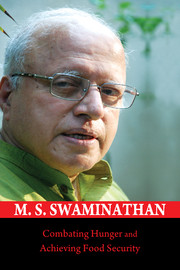Book contents
- Frontmatter
- Contents
- Foreword
- Preface
- Acknowledgements
- Abbreviations
- 1 Genesis and Growth of the Yield Revolution in Wheat
- 2 Our Agricultural Heritage
- 3 Shaping Our Agricultural Destiny
- 4 Thrust on Farm Revival
- 5 Nutri-farm Movement
- 6 Nutrition-sensitive Agriculture
- 7 Food Losses and Food Waste
- 8 Rice in Zero Hunger Challenge
- 9 Monsoon Management
- 10 Importance of Ecological Conservation
- 11 Caring for Ecology and Heritage
- 12 Conserving Biodiversity
- 13 Overcoming Hidden Hunger through Aquaculture
- 14 Biofuels – The Way to Go
- 15 Food Security
- 16 Vigilance for Sustainable Food Security
- 17 Food Security and Social Protection
- 18 Food Security and its Role
- 19 Sustaining the Livestock Revolution
- 20 Challenges in the Year of Science
- 21 Agriculture and Humanism
- 22 Fostering the Science of Science Communication
- 23 Olympic Move for Saving Children
- 24 Youth: The Agents of Change
- 25 Role of Women in Agricultural Production
- 26 Know-how to Do-how
- 27 From Bengal Famine to Right to Food
- 28 Financial Institutions and Fighting Food Inflation
- 29 Public Good Research in Agriculture
- 30 The Future of Indian Agriculture
- Bibliography
Preface
Published online by Cambridge University Press: 18 December 2015
- Frontmatter
- Contents
- Foreword
- Preface
- Acknowledgements
- Abbreviations
- 1 Genesis and Growth of the Yield Revolution in Wheat
- 2 Our Agricultural Heritage
- 3 Shaping Our Agricultural Destiny
- 4 Thrust on Farm Revival
- 5 Nutri-farm Movement
- 6 Nutrition-sensitive Agriculture
- 7 Food Losses and Food Waste
- 8 Rice in Zero Hunger Challenge
- 9 Monsoon Management
- 10 Importance of Ecological Conservation
- 11 Caring for Ecology and Heritage
- 12 Conserving Biodiversity
- 13 Overcoming Hidden Hunger through Aquaculture
- 14 Biofuels – The Way to Go
- 15 Food Security
- 16 Vigilance for Sustainable Food Security
- 17 Food Security and Social Protection
- 18 Food Security and its Role
- 19 Sustaining the Livestock Revolution
- 20 Challenges in the Year of Science
- 21 Agriculture and Humanism
- 22 Fostering the Science of Science Communication
- 23 Olympic Move for Saving Children
- 24 Youth: The Agents of Change
- 25 Role of Women in Agricultural Production
- 26 Know-how to Do-how
- 27 From Bengal Famine to Right to Food
- 28 Financial Institutions and Fighting Food Inflation
- 29 Public Good Research in Agriculture
- 30 The Future of Indian Agriculture
- Bibliography
Summary
At the close of the 2012 London Olympics, the United Kingdom announced a programme designed to rescue 25 million children worldwide from malnutrition by the time of the next Olympics in Brazil. In May 2012, the World Health Assembly agreed to a target of reducing the number of stunted children by 40 per cent (a reduction of about 70 million children) by 2025. To meet these targets and nourish the 870 million hungry people in the world, the world's leaders will need to prioritize an innovative science-based marriage of nutrition and agriculture.
The problem of hunger is not simply a lack of sufficient quantities of food. The chronic hunger caused by protein and calorie under-nutrition is exacerbated by malnutrition (the ‘hidden’ hunger caused by the deficiency of micronutrients, which include iron, iodine, zinc, vitamin A and vitamin B12), and sometimes by human diseases that disable the body's ability to absorb the micronutrients it receives. To address such intertwined problems, there must be synergy among national programmes dealing with the availability, access to, and absorption of food. These nutrition security programmes should be based on a life-cycle approach that starts with the ‘first 1000 days’ from pregnancy to two year old, the critical period when stunting can cause irreversible damage.
The United Nations (UN) Committee on World Food Security has released a comprehensive report on Social Protection for Food Security with recommendations for combating chronic childhood hunger. One of its recommendations – the concept of a ‘food security floor’ – is particularly worthy of mention. The food security floor recognizes the fact that freedom from hunger is a fundamental human right, defining the minimal steps needed for hunger elimination. These include nutrition literacy, clean drinking water, sanitation and primary health care.
In some ‘hunger hotspots’ of the world where agriculture is the backbone of survival, as in sub-Saharan Africa and South Asia, mainstreaming nutrition in agriculture programmes is the most effective and low-cost method of eliminating malnutrition. This requires greater attention to the net income of smallholder farmers, whose women food producers have particular needs that require specific policies and support. As an example, the M. S. Swaminathan Research Foundation in Chennai, India, has designed a Farming System for nutrition initiative, comprising specific steps.
- Type
- Chapter
- Information
- Combating Hunger and Achieving Food Security , pp. xi - xiiiPublisher: Cambridge University PressPrint publication year: 2016



